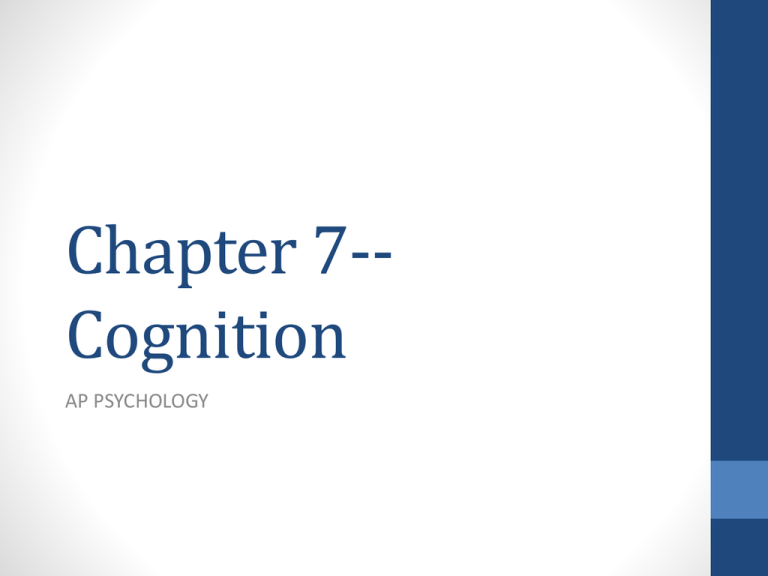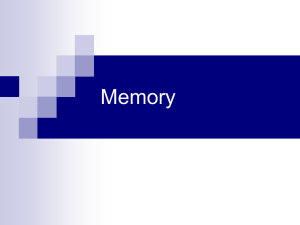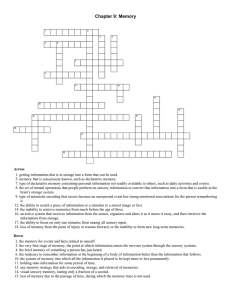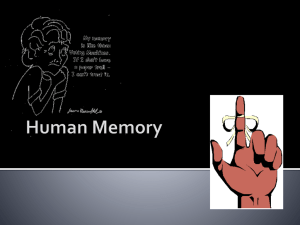Ch. 7 Slides
advertisement

Chapter 7-Cognition AP PSYCHOLOGY Memory • Take out a piece of paper and name the 7 dwarfs Difficulty of Task • Was the exercise easy or difficult? • It depends on what factors? • Whether you like Disney movies • how long ago you watched the movie • how loud the people are around you when you are trying to remember Cognition--Memory • Cognitive psychologist view memory as a system of that encodes, stores, and retrieves information. • Human memory works closely with the perceptual system, which takes information from the senses an selectively converts it to meaningful patterns that can be stored and accessed later when needed Memory—Spot the Real Penny Human Memory is Good At: • • • • • Information on which attention is focused Information in which we are interested Information that arouses us emotionally Information that fits with our previous experiences Information that we rehearse Memory’s 3 Basic Tasks • Human memory takes essentially meaningless sensory information and changes it into meaningful patterns that you can use and store later…this is called Information- Processing Model Memory’s 3 Basic Task • The memory process: • Encoding • Storage • Retrieval Encoding • Involves the modification of information to fit the preferred format of the memory system. • You are RECORDING information into your memory. Encoding • Deliberate encoding effort called—elaboration. • Elaboration: You connect a a new concept with existing information already stored. • Assimilation: absorbing new information and placing it in already existing schemas Encoding Examples • Typing information into a computer • Getting a girls name at a party Storage • 2nd essential memory task. • Involves the retention of encoded material overtime. Storage Examples • Pressing Ctrl S and saving information • Trying to remember the girl’s name Retrieval • 3rd Stage of the Memory Process. • Involves the location and recovery of information from memory Retrieval Examples • Finding your saved document and opening it up. • Seeing the girl from the party the next day…and calling her the wrong name (retrieval failure) How Do We Form Memories? • Core Concept: • Each of the three memory stages encodes and stores memories in a different way, but they work together to transform sensory experience into a lasting record that has a pattern of meaning How do we form memories? • The three stages to forming memories work like an assembly line to convert the flow of incoming stimuli into meaningful patterns than can be stored and later remembered. • Model originally created by Richard Atkinson and Richard Shiffrin. Memory Flow Sensory Memory Working Memory Includes shortterm memory Long Term Memory LT memory also flows back to working memory Sensory Memory • Most fleeting of the 3 stages. • Typically holds sights, sounds, smells, textures, for only a fraction of a second • One function– is to maintain incoming sensory information to be screened for possible use and entry into working memory. Sensory Memory Example Sensory Memory • How many letters can you recall? Sensory Memory • The actual capacity of sensory memory can be twelve or more items. • All but three or four items disappear before they can enter consciousness. • There is a separate sensory register for each sense. • Psychologists believe that, in this stage, memory images take the form of nerve impulses. Biological Base of Sensory Memory Working Memory • 2nd Stage of Processing. • Originally called Short Term memory (STM) • Preserves recently perceived events or experiences for less than a minute without rehearsal. Working Memory • Takes information selectively from the sensory register and connects it with items already in long term storage (That Rings a Bell). • Working memory is built to hold information for a few seconds (about 20), making it a useful buffer for temporarily holding items. Important Facts • Everything entering consciousness passes into working memory. • Storage capacity is significantly smaller than that of sensory memory. • It has the smallest storage capacity of the 3 memory stages. Structure of Working Memory • Chunking – Organizing pieces of information into a smaller number of meaningful units. • Phone number • Maintenance rehearsal – Process in which information is repeated or reviewed to keep it from fading while in working memory. • “Cramming” for a test. Does not help info get to LTM. Structure of Working Memory • Elaborative rehearsal – Process in which information is actively reviewed and related to information already in LTM. • Not merely repeated, but actively connected to knowledge already stored. Structure of Working Memory • Working memory consists of: • A central executive • A phonological loop • The sketchpad Central Executive Phonological Loop • “Pop” “Splash” • Acoustic Encoding • What lobe? Sketchpad • (Visual and Spatial) Sketchpad does what? What lobes? Levels of Processing in WM • Who are Craik and Lockhart? And what did they create? • What was their experiment? Encoding and Storage in Working Memory • Levels-of-processing theory – Explanation for the fact that information that is more thoroughly connected to meaningful terms in LTM will be better remembered. 7 Dwarfs… • Who are they? • • • • • • • Doc Grumpy Happy Sleepy Bashful Sneezy Dopey Biological Basis of WM Long Term Memory LTM • Final Stage of processing • Stores material organized according to meaning. • Receives information from WM and can store it for much longer periods of time. • Holds varied material (mothers face, favorite song lyrics). • LTM holds each person’s total knowledge of the world and self. Structure and Function of LM • Procedural memory – Division of LTM that stores memories for how things are done. • A register for the things we know how to DO. • Declarative memory – Division of LTM that stores explicit information (also known as fact memory). • A register which acts as storage for the information that we can describe. Procedural Memory • Facts: Declarative • Add Facts! Divisions of Declarative Memory • Episodic memory – Subdivision of declarative memory that stores memories for personal events, or “episodes”. • Semantic memory – Subdivision of declarative memory that stores general knowledge, including meanings of words and concepts LTM LTM Procedural Declarative Memory Includes memory for: Semantic Memory Episodic Memory: Includes memory for: Events, personal experience Language, facts, general knowledge Motor skills, operant and classical conditioning Biological Basis of LTM The search for the “engram” the biological basis of LTM has taken two approaches. • Engram – The physical trace of memory. • What are the approaches? 1. Neural 2. Synapses Biological Basis • What are the approaches? • • 1. Neural: 2. Synapses : Clues from the Tragic Cases of H.M. • Who is H.M.? What happened to him? Details/Facts! Clues from the Tragic Cases of H.M. • Anterograde amnesia – Inability to form memories for new information. • Retrograde amnesia – Inability to remember information previously stored in memory. Parts of the Brain Associated with LTM • What role does each play: • Hippocampus: • Amygdala: Memories, Neurons, and Synapses • 2nd approach to the engram has concentrated on the biology and chemistry of neurons and their synapses. • Long term potentiation: • While memories are consolidating they can also be strengthened by the person’s emotional state—which accounts for our especially vivid memories of emotionally arousing experiences. Flashbulb Memory • This is the closes most people will come to having a “photographic memory”. • It is an exceptionally clear recollection of an important emotion-packed event—a very vivid episodic memory. • What are some of your “flashbulb” memories? Memories • Whether memories are implicit or explicit, successful retrieval depends on how they were encoded and how they are cued. • So….what are implicit and explicit memories? Memories • Implicit- memory that can affect your behavior but which you did not deliberately learn or of which you currently have no awareness. • Explicit- Involves awareness. A memory that has been processed with attention and can be consciously recalled. • Examples? Retrieval Cues • Stimuli that are used to bring a memory to consciousness or into behavior • “Search terms” used to activate memory. • Examples: smelling fresh baked cookies brings back memories of Grandma’s house. • Whether a retrieval cue is a good one, depends on the type of memory being sought and the web of associations its connected to. Priming (Implicit Memories) • Procedure of providing cues that stimulate memories without awareness of the connection between the cue and retrieved memory. Retrieving Explicit Memories • Anything stored in LTM must be “filed” according to its pattern or meaning. • Process Elaborate- best way to add material to LTM is to associate it, while in working memory, with material already stored in LTM. Meaningful Organization • If you want to store new information in your LTM, you must make it meaningful while it is in working memory. • This requires you to associate new information with things you already know. • Ex- Thinking of personal examples for new concepts. Recall vs. Recognition • Retrieval of explicit memories can be cued in two main ways. One is required on an essay test while the other is required on multiple choice. • 1. Recall • 2. Recognition Recall • (Essay Test) a retrieval task in which you must create an answer almost entirely from memory. • Technique for retrieving explicit memories in which one must reproduce previously presented information • Example: What are the three memory stages? Recognition • (Multiple Choice) Retrieval tasks in which you merely identify whether a stimulus has been previously experienced. • Technique for retrieving explicit memories in which one must identify present stimuli as having been previously presented • Normally is less demanding than recall because the cues available for a recognition task are much more complete. • Also used by police to in a lineup Encoding Specificity • Involve situations in which the context affected the way a memory was encoded and stored—influencing the retrieval at a later time. • Encoding specificity principle – The more closely the retrieval clues match the form in which the information was encoded, the better the information will be remembered • Example- seeing your psychology teacher at the grocery store. • Talking to a childhood friend and being flooded with memories. Other Factors Affecting Retrieval • Influences related to the context in which you encoded a memory and also the context in which you are remembering affect the way in which you will retrieve memories. Mood and Memory • Moods can create a bias in our perceptions and affect what we pull out of memory. • People who are depressed often report that all their thoughts have a melancholy aspect...why? Mood-Congruent Memory • A memory process that selectively retrieves memories that match (congruent with) one’s mood. • Also can have important health implications • Because depressed people are likely to emphasize their medical symptoms, they may receive treatment that is much different from someone else. Tip of your tongue… • Who has the names of the 7 dwarfs? • TOT Phenomenon- the inability to recall a word, while knowing that it is in memory. • Normally occurs bc of “interference”- when another memory blocks access or retrieval. • Normally you can RECOGNIZE words but can’t RECALL them Why Does Memory Sometimes Fail Us? • Core concept: • Most of our memory problems arise from memory’s “seven sins” – which are really by-products of otherwise adaptive features of human memory. How does memory fail us? • “Seven Sins of Memory” • • • • • • • 1. Transience 2. Absent-Mindedness 3. Blocking 4. Misattribution 5. Suggestibility 6. Bias 7. Persistence Transience: Fading memories causes forgetting • The impermanence of a long-term memory. Based on the idea that long term memories gradually fade in strength over time. • Ebbinghaus Experiment: • Forgetting curve: • A graph plotting the amount of retention and forgetting over time for a certain batch of material. • Captures the pattern of transience by which we forget the verbal material we learn. Ebbinghaus’s Forgetting Curve Recall decreases rapidly, then reaches a plateau, after which little more is forgotten Absent-Mindedness • A memory hasn’t disappeared from your brain circuits, rather you have suffered from retrieval failure caused by shifting your attention elsewhere. • Forgetting an anniversary because of a big final exam. • * Forgetting caused by lapses in attention. Blocking • Blocking occurs when information has encountered interference—when 1 item acts as an obstacle to accessing and retrieving another memory. • Common cause: old habits getting in the way of a new one 3 Causes for Interference • 1. The greater the similarity btw two sets of material learned, the greater the interference btw them is likely to be. • 2. Meaningless material is more vulnerable to interference than meaningful material because LTM is organized by meaning. • 3. Emotional material is a powerful cause of interference. Interference • Three types; • 1. Proactive • 2. Retroactive • 3. The Serial Position Effect Proactive • When an old memory disrupts the learning and remembering of new information. • Example, your silverware has been in the same draw for years. You go away to college, come back and its moved. You keep going to the same draw. • Pro means “forward” old memories act forward in time to block you attempts at new learning Retroactive • Newly learned information prevents the retrieval of previously learned material. • Newer material reaches back into your memory to block access to old material. • “Retro” meaning backwards Interference Serial Position Effect • A form of interference related to the sequence in which information is presented. • Generally, items in the middle of a sequence are less likely to be remembered. • You are more likely to remember the names of those you met first and last. Misattribution • Memories are retrievable, but when they are retrieved they are associated with the wrong time, place, or person. • Cause people to believe mistakenly that other people’s idea, stories, thoughts, are there own. Suggestibility • Memories can be distorted or created by suggestion. • Elizabeth Loftus and John Palmer investigate suggestibility. • Misinformation effect: The distortion of memory by suggestion or misinformation. Suggestibility Experiment • Memory Distortion Experiment: Participants watched a film of two cars colliding. Then the experimenters asked them to estimate how fast the cars were going. The witnesses responses were prompted by 2 questions. • 1. How fast were the cars going when they smashed into each other? • 2. How fast were the cars going when they hit each other? Suggestibility Experiment • The group who got the question with “smash” answered their question with a higher speed. • Ironic? • This distortion of the question cause the misinformation effect. Factors Affecting the Accuracy of Eyewitnesses: • Recollections are less influenced by leading questions if possibility of memory bias is forewarned. • Passage of time leads to increase in misremembering information. • Age of the witness matters. • Confidence in memory is not a sign of accuracy. • http://www.youtube.com/watch?v=WFRiDtUbeAQ Bias • Refers to the influence of personal beliefs, attitudes, and experiences on memory. • Expectancy Bias- In a memory, a tendency to distort recalled events to make them fit one’s expectations. • Self Consistency Bias- Commonly held bias that we are more consistent in our attitudes, beliefs and opinions that we actually are. Persistence • A memory problem in which unwanted memories cannot be put out of mind. • Seen in phobias The Advantages of the “Seven Sins” of Memory • Despite the grief they cause us, the “seven sins” may actually be by-products of adaptive features of memory. • For example, absent-mindedness is the by-product of the useful ability to shift our attention. • Misattributions, biases, and suggestibility result from a memory system built to deal with meaning.








